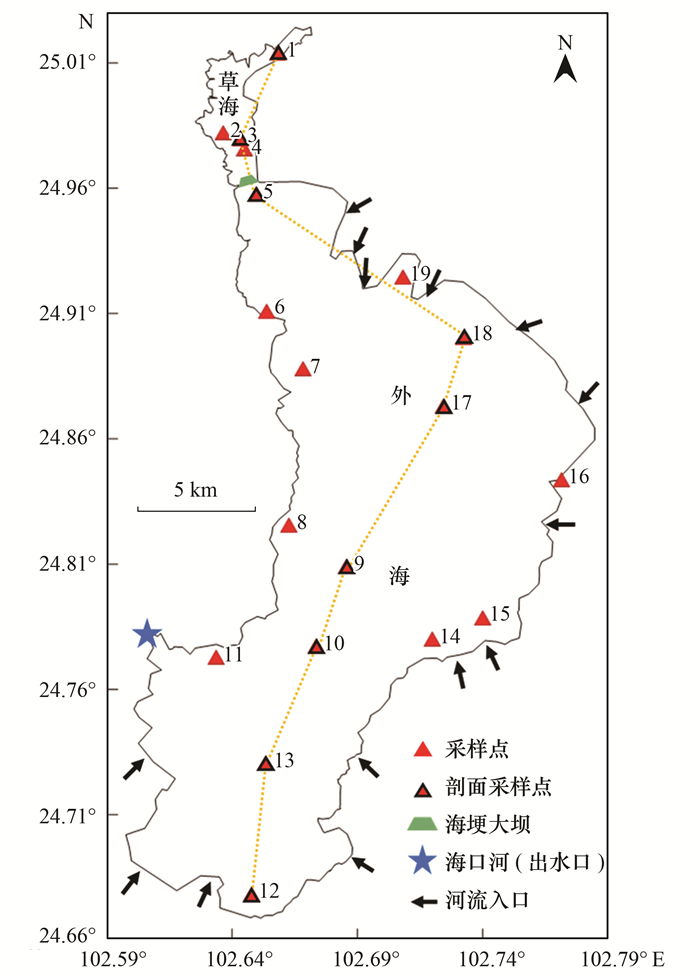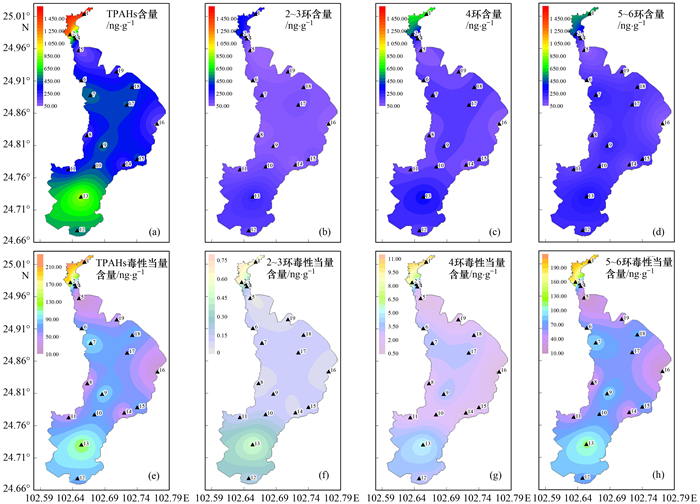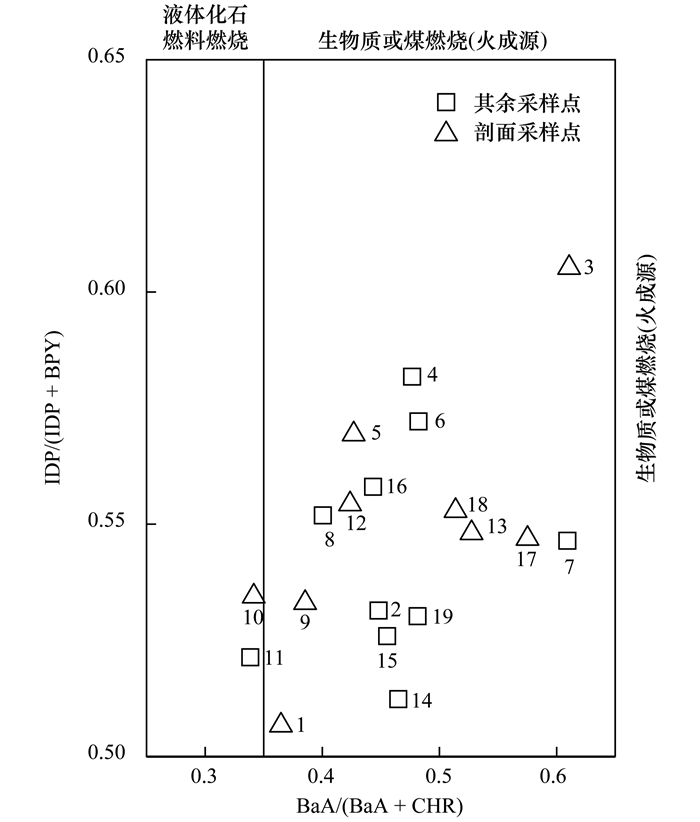2. 清华大学环境学院, 北京 100084;
3. 北京市食品环境与健康工程技术研究中心, 北京 100081;
4. 自然资源部生态地球化学重点实验室, 北京 100037;
5. 中国地质环境监测院, 北京 100081
2. School of Environment, Tsinghua University, Beijing 100084, China;
3. Beijing Engineering Research Center of Food Environment and Public Health, Beijing 100081, China;
4. Key Laboratory of Ecological Geochemistry, Ministry of Land and Resources, Beijing 100037, China;
5. Chinese Institute of Geo-environmental Monitoring, Beijing 100081, China
滇池是我国西南地区重要的淡水湖泊.为改善滇池的水环境质量, 近年来全面实施了环湖截污、引水入滇(即牛栏江-滇池补水工程)等六大工程, 外源污染得到有效控制. 2016年, 滇池水质近20年首次由劣Ⅴ类提升为Ⅴ类[1], 内源污染物已成为影响水质的关键因素.
多环芳烃(PAHs)是一类至少含有两个苯环的有机化合物, 广泛分布于环境介质中, 其中一些种类具有“三致”效应[2].除极少量由自然过程产生外, PAHs主要由工业过程、生物质燃烧和化石燃料燃烧等人类活动产生、排放, 并通过各种途径进入水、土壤、大气等环境介质, 经食物链生物放大与富集后, 威胁人类健康和生态安全[3].我国PAHs排放强度大[4]、污染范围广[5~13].水体是环境中PAHs重要的汇, 因其具有疏水性, 水体中的PAHs吸附到悬浮颗粒后沉降于沉积物, 或直接被表层沉积物富集, 因此, 表层沉积物是水体中PAHs的重要储库.
截污调水前, 滇池流域表层沉积物中PAHs含量较高, 具有潜在生态风险[12~16].截污调水工程实施后, 滇池水质、水量变化极可能造成表层沉积物中PAHs解吸, 形成二次污染.对于滇池水质首次全面转好(2016年)之后的水质管控而言, 掌握滇池全湖范围表层沉积物分布特征, 对于滇池水质的保持与提升具有重要意义.为分析滇池截污调水后表层沉积物中PAHs的分布情况, 本文于2016年12月采集了滇池19个表层沉积物样品, 以气相色谱-质谱联用法(GC-MS)分析样品中美国环境保护署(USEPA)列出的16种优先控制PAHs的含量, 解析其时空分布特征、来源及生态风险.
1 材料与方法 1.1 样品的采集在滇池全湖范围内, 河流入湖口、湖滨带及湖泊中心等典型功能区域均匀布设19个采样点(图 1), 其中草海4个采样点(1~4号), 外海15个采样点(5~19号).草海和外海以海埂大坝为界, 5号采样点设置在海埂大坝附近. 9个采样点(1、3、5、18、17、9、10、13和12号)大致由北向南分布, 视为剖面, 以解析表层沉积物中PAHs的空间分布特点.采样时间为2016年12月4~5日, 当日微风, 湖水平静.以柱状重力采样器(采样管直径10 cm, 长度80 cm)采集滇池底部0~20 cm的表层沉积物, 样品以聚乙烯自封袋密封后置于采样箱中低温保存, 上岸后将样品冷冻保存(-18℃), 经冷冻干燥(约-50℃)后研磨过60目筛(0.25 mm), 置于聚乙烯自封袋中在4℃以下保存备用.

|
图 1 滇池表层沉积物采样点布置 Fig. 1 Sampling site layout for surface sediments in Dianchi Lake |
16种PAHs的混合标准溶液, 包括萘(NAP)、苊烯(ACY)、苊(ACE)、芴(FLU)、菲(PHE)、蒽(ANT)、荧蒽(FLT)、芘(PYR)、苯并[a]蒽(BaA)、

向2 g样品中加入2 g Na2SO4, 以脱脂滤纸包覆, 置于索氏提取管内.向管内加入10 μg·mL-1的替代物(2-氟联苯和对三联苯-D14混合标准溶液)10 μL, 向已加入石油醚的平底烧瓶中加入少许铜片, 回流6~8 h.转移残液, 氮吹浓缩(KL512/509J型12位氮吹仪, 配数控恒温水浴, 北京康林科技有限责任公司), 加入10 μg·mL-1的内标物10 μL后以正己烷定容至1.0 mL待测.
1.4 GC-MS分析日本Shimadzu QP-2010 Ultra气质联用仪.美国Agilent公司DB-5MS色谱柱(30.0 m×0.25 mm i. d., 膜厚0.25 μm.升温程序:初始温度70℃, 保留3 min, 以10℃·min-1升温至270℃, 保留1 min, 以5℃·min-1升温至285℃, 以10℃·min-1继续升温至305℃, 保留10 min.进样口、四极杆温度为280℃, 离子源温度为240℃.载气流速为1.3 mL·min-1, 不分流模式进样1 μL.电子轰击(EI)离子源, 选择离子模式(SIM)定量分析.
1.5 质量控制采用空白样品、空白加标样品、平行样品控制数据质量.以石英砂为空白基质, 其中加入氘代混合PAHs标准(萘-D8、苊-D10、菲-D10、
滇池表层沉积物中TPAHs含量范围为92.31~1 546.78 ng·g-1, 平均含量为496.30 ng·g-1(以干重计); 各类PAHs的含量在0~264 ng·g-1之间, 平均值为34.42 ng·g-1(表 1).滇池表层沉积物中TPAHs含量呈现以下分布趋势[图 2(a)]:以海埂大坝为界, 海埂大坝以北区域(草海), TPAHs含量自北向南逐渐减小; 海埂大坝以南区域(外海), TPAHs含量整体分布均匀, 南部略高, 沿岸略低于湖心.采样前最近的一次草海湖底清淤工程, 中部及北部于2002年完成, 其余地区于2010年完成.草海中部及北部污染物再次淤积, 导致中北部表层沉积物中TPAHs含量高于南部.湖泊沿岸地区疏浚更加容易、彻底, 同时, 滇池流域水网密布, 沿岸分布多个入湖口, 复杂的水利条件、较快的流速不利于污染物的沉积, 使得外海沿岸地区的TPAHs含量低于湖心.
|
|
表 1 滇池表层沉积物中PAHs的含量1)/ng·g-1 Table 1 PAHs concentrations in the surface sediments of Dianchi Lake/ng·g-1 |

|
图 2 滇池表层沉积物中PAHs含量及毒性当量含量空间分布 Fig. 2 Distribution of PAHs concentrations and TEQ concentrations in the surface sediments of Dianchi Lake |
草海表层沉积物中TPAHs含量(411.85~1 546.78 ng·g-1)明显高于外海(92.31~866.78 ng·g-1), 不同种类PAHs的含量较外海高0.74~2.45倍.草海曾长期作为昆明市生产生活污水的受纳水体, 污染物随污水排入草海后, 经海埂大坝缓慢流入外海, 污染物进入外海后得到稀释, 草海表层沉积物中较外海截留了更多PAHs.
表 2对比了Zhao等[13]于2012年12月采集的滇池表层沉积物中PAHs及本研究的变化情况.从全湖、草海和外海这3个方面比较, 2016年滇池表层沉积物TPAHs含量均发生了显著下降.全湖TPAHs平均含量下降1 047 ng·g-1(降幅67.8%), 草海下降3 816 ng·g-1(降幅80.4%), 外海下降682 ng·g-1(降幅64.2%). TPAHs含量大幅下降, 推测与截污调水工程密切相关.截污工程有助降低PAHs排放、进入水体的总量, 调水工程通过增加入湖水量、提升了水体的更新速度, 都可能是滇池表层沉积物中TPAHs含量降低的重要原因. 表 3汇总了近10年我国重点水域表层沉积物中TPAHs的含量情况, 2016年滇池表层沉积物中TPAHs含量在我国重点水域中已处于较低水平.
|
|
表 2 滇池2012年表层沉积物PAHs含量与本研究对比 Table 2 Comparison of PAH concentrations in the surface sediments of Dianchi Lake in 2012 and during the study period |
|
|
表 3 我国重点水域表层沉积物中TPAHs含量 Table 3 Concentrations of TPAHs in the surface sediments of key waters in China |
不同种类PAHs的毒性差异较大, 含量不能直接客观表达毒性水平.为评估表层沉积物采样点中PAHs的毒性, 以BaP为基准, 将不同种类PAHs按毒性重新计量获得毒性当量(TEQ).按式(1)归一化计算各采样点PAHs的毒性当量含量:

|
(1) |

|
(2) |
式中, CTEQi是采样点中第i种PAHs物质的毒性当量含量, Ci是第i种PAHs物质的含量, TEFi是第i种PAHs物质的毒性当量因子, CTEQ是TPAHs的毒性当量含量.本研究中, 滇池表层沉积物中TPAHs毒性当量含量介于14.12~215.36 ng·g-1之间, 平均为77.88 ng·g-1[图 2(e)].草海表层沉积物的TPAHs毒性当量含量平均值(130.29 ng·g-1)是外海(63.90 ng·g-1)的2.04倍. PAHs毒性当量含量与含量变化趋势大体相同, 沿岸低、中心高的分布情况更为明显[图 2(e)~2(h)].对毒性当量含量贡献最大的物质为DBA(各采样点平均42.97 ng·g-1), 占各采样点TPAHs平均毒性当量含量的55.17%.
本研究关注的16种PAHs, 根据来源及结构差异可分为2~3环PAHs(NAP、ACY、ACE、FLU、PHE、ANT)、4环PAHs(FLT、PYR、BaA、CHR)和5~6环PAHs(BbF、BkF、BaP、DBA、BPY、IDP)这3类.滇池表层沉积物中不同环数PAHs的含量分布特征与TPAHs近似, PAHs来源无显著差异[图 2(b)~2(d)].各滇池表层沉积物采样点中, 2~3环PAHs含量在16.08~369.43 ng·g-1范围内, 平均含量为101.68 ng·g-1; 4环PAHs含量范围为42.18~720.40 ng·g-1, 平均含量为201.80 ng·g-1; 5~6环PAHs含量分布在34.05~555.43 ng·g-1范围内, 平均含量为192.82 ng·g-1. PAHs组成以4环及5~6环为主[图 3(a)], 含量分别占总含量的40.38%和40.22%, 主要由于高环PAHs的辛醇-水分配系数大, 疏水性更强, 更易于向沉积物相分配[26], 较2012年滇池表层沉积物PAHs组成情况大体一致(表 2)[13, 26]. 5~6环PAHs在总毒性当量含量中占比最高, 达到了95%以上[图 3(b)], 环境风险主要由5~6环PAHs贡献, 高环PAHs与化石燃料高温燃烧、裂解密切相关[27, 28], 为进一步降低其环境风险, 可以此为切入点着手控制.

|
图 3 滇池表层沉积物中不同环数的PAHs组成 Fig. 3 Composition of PAHs with different rings in the surface sediments of Dianchi Lake |
滇池有14条主要入湖河流, 大多分布于滇池东岸, 只有一个天然出水口, 位于滇池西南侧海口镇附近, 牛栏江-滇池补水工程经盘龙江、大清河、宝象河、马料河和洛龙河等5条河流进入滇池[17].湖心地区较沿岸污染物混合更加均匀, 水流也更为平缓, 利于污染物的沉积.为清晰直观地反映滇池表层沉积物中PAHs南北走向的分布规律以为后续工程实施提供初步依据, 同时尽量减少滇池四周复杂的水力条件及频繁的人为活动对沿岸污染物分布情况的干扰, 本研究选取了位于湖心且贯穿滇池的9个采样点绘制剖面图(图 4). TPAHs含量及毒性当量含量最高值出现在草海(1号采样点)分别为1 546.78 ng·g-1和215.36 ng·g-1, 海埂大坝附近(5号采样点)出现TPAHs含量(92.31 ng·g-1)及毒性当量含量(14.12 ng·g-1)最低点, 且在外海呈现总体平稳的趋势. 18、17、9、10、13、12号采样点剖面上TPAHs含量平均值为534.10 ng·g-1, 由422.43 ng·g-1略增至519.33 ng·g-1, 毒性当量含量由77.34 ng·g-1略增至78.99 ng·g-1.剖面采样点2~3环PAHs占比由南向北缓慢递增(17.52%~27.60%), 草海(1号和3号采样点)4环PAHs占比最高, 自北向南逐渐降低(46.57%~33.69%), 5~6环PAHs占比于18、17、9、10号采样点剖面上发生了较大波动外, 其余点位占比平稳.

|
图 4 南北剖面上PAHs分布规律 Fig. 4 Distribution of PAHs across a north-south profile |
分子比值法在解析湖泊表层沉积物PAHs的来源中应用十分广泛[12, 14~16].本研究采用BaA/(BaA+CHR)和IDP/(IDP+BPY)这2种特征分子比值, 讨论滇池表层沉积物PAHs的主要来源.
通常, BaA/(BaA+CHR)小于0.20、IDP/(IDP+BPY)小于0.20时, PAHs主要源自造岩源; BaA/(BaA+CHR)在0.20~0.35范围内、IDP/(IDP+BPY)在0.20~0.50范围内时, PAHs主要来源于液体化石燃料的燃烧; BaA/(BaA+CHR)大于0.35、IDP/(IDP+BPY)大于0.50时, PAHs的来源以生物质或煤的燃烧为主[29, 30].滇池表层沉积物采样点中BaA/(BaA+CHR)的比值范围为0.34~0.61(均值0.55), IDP/(IDP+BPY)的比值范围为0.51~0.61(均值0.55),见图 5, PAHs的主要来源是生物质或煤的燃烧过程.同时, 有个别采样点(10号和11号采样点)的BaA/(BaA+CHR)比值显示出液体化石燃料燃烧的影响, 滇池中船只的燃油燃烧可能是造成比值异常的主要原因. 10号采样点位于外海南部湖心, 距离岸边较远, 生物质、燃煤影响较小; 11号采样点位于海口镇附近, 临近滇池唯一的出水河道, 往来船只密集, 燃油燃烧影响集中.滇池表层沉积物PAHs的来源自2012年起无明显改变[13], 生物质或煤的燃烧依旧处于污染源中的主要地位.

|
图 5 滇池表层沉积物PAHs的特征分子比值分布 Fig. 5 PAHs cross plots for the ratios of IDP/(IDP+BPY) and BaA/(BaA+CHR) in the surface sediments of Dianchi Lake |
应用Long等[31]提出的潜在生态风险标志对比法评估滇池表层沉积物中PAHs的生态风险.表层沉积物中PAHs含量若低于生物影响范围低值(ER-L), 则生态风险较低, 对生物的毒副作用不明显, 极少产生负面生态效应; 若高于生物影响范围中值(ER-M)会导致严重的生态风险, 对生物会产生明显的毒副作用, 负面生态效应常见; 若介于二者之间, 则偶尔发生负面生态效应, 具有潜在的生态风险.关于BbF、BkF、IDP和BPY这4种PAHs的生态风险尚无明确结论, 本研究暂不考虑.
生态风险评价结果表明(表 4), 12种PAHs中除FLU、DBA外, 最大含量均低于ER-L, 而部分采样点中的FLU和DBA含量超过ER-L, 说明滇池表层沉积物中FLU、DBA对生物具有潜在的毒性作用, 但不会导致急性毒性效应, 整体生态风险较低. FLU含量的平均值已经超过ER-L, 其中超标点位有6个(草海1、2、3和4号采样点, 外海12号和13号采样点), 草海全部点位均出现FLU超标问题, 最大值出现在2号采样点(91.4 ng·g-1). DBA均值未超过ER-L, 但依旧存在2个点位超标(1号和2号采样点), 均分布在草海.草海表层沉积物中PAHs的生态风险较外海高, 主要是曾长期受纳昆明生产生活污水的历史原因所致.
|
|
表 4 滇池表层沉积物中PAHs的含量与ER-L、ER-M比较1)/ng·g-1 Table 4 Concentrations of PAHs in the surface sediments of Dianchi Lake compared with ER-L and ER-M/ng·g-1 |
2012年, 滇池表层沉积物的部分采样点中有多种PAHs含量介于ER-L与ER-M之间, 其中FLU、CHR含量超标点位最多; PYR及CHR含量最高值已超过ER-M, 属于严重生态风险情况[13].滇池整体生态风险较2012年显著降低, 目前处于相对安全的范围内, 但是草海问题存在已久, 需继续关注, 建议有针对性地加强草海的疏浚工作.
3 结论(1) 滇池表层沉积物中TPAHs含量范围介于92.31~1 546.78 ng·g-1之间, 平均值为496.30 ng·g-1, 在我国重点水域中处于较低水平.草海表层沉积物的TPAHs含量高于外海, 海埂大坝附近出现最低值, 主要污染物为FLT(80.65 ng·g-1).与2012年相比, 滇池表层沉积物的TPAHs含量显著下降.
(2) 滇池表层沉积物中TPAHs毒性当量含量为14.12~215.36 ng·g-1, 平均值为77.88 ng·g-1, 对毒性当量含量影响最大的物质为DBA(42.97 ng·g-1). PAHs组成以中高环PAHs为主, 5~6环PAHs在总毒性当量含量中占比最高, 较2012年滇池表层沉积物PAHs组成情况大体一致.
(3) 滇池表层沉积物中PAHs的主要来源是生物质或煤的燃烧过程.通过潜在生态风险标志对比法评估生态风险, 滇池表层沉积物中PAHs的生态风险整体较低, 但草海仍存在生态风险问题, 值得继续关注与治理.
| [1] |
代艳芳, 吴琨, 胡清顺. 调水工程管理适应水资源区域配置实践与探索——以牛栏江-滇池补水工程为例[J]. 中国水利, 2018(14): 41-44. Dai Y F, Wu K, Hu Q S. Practices of water diversion scheme management adapts to regional allocation:taking the Niulanjiang River-the Dian Lake water diversion scheme as an example[J]. China Water Resources, 2018(14): 41-44. DOI:10.3969/j.issn.1000-1123.2018.14.016 |
| [2] | Readman J W, Fillmann G, Tolosa I, et al. Petroleum and PAH contamination of the Black Sea[J]. Marine Pollution Bulletin, 2002, 44(1): 48-62. |
| [3] | Kang M J, Yang F, Ren H, et al. Influence of continental organic aerosols to the marine atmosphere over the East China Sea:insights from lipids, PAHs and phthalates[J]. Science of the Total Environment, 2017, 607-608: 339-350. DOI:10.1016/j.scitotenv.2017.06.214 |
| [4] | Zhang Y X, Tao S, Shen H Z, et al. Inhalation exposure to ambient polycyclic aromatic hydrocarbons and lung cancer risk of Chinese population[J]. Proceedings of the National Academy of Sciences of the United States of America, 2009, 106(50): 21063-21067. DOI:10.1073/pnas.0905756106 |
| [5] | Wang Z C, Liu M, Yang Y. Characterization and sources analysis of polycyclic aromatic hydrocarbons in surface sediments in the Yangtze River Estuary[J]. Environmental Earth Sciences, 2015, 73(5): 2453-2462. DOI:10.1007/s12665-014-3594-x |
| [6] | Wang M, Wang C Y, Li Y W. Petroleum hydrocarbons in a water-sediment system from Yellow River estuary and adjacent coastal area, China:distribution pattern, risk assessment and sources[J]. Marine Pollution Bulletin, 2017, 122(1-2): 139-148. DOI:10.1016/j.marpolbul.2017.06.037 |
| [7] | Zhao Z H, Zhang L, Wu J L. Polycyclic aromatic hydrocarbons (PAHs) and organochlorine pesticides (OCPs) in sediments from lakes along the middle-lower reaches of the Yangtze River and the Huaihe River of China[J]. Limnology and Oceanography, 2016, 61(1): 47-60. DOI:10.1002/lno.10197 |
| [8] | He Y, Meng W, Xu J, et al. Spatial distribution and potential toxicity of polycyclic aromatic hydrocarbons in sediments from Liaohe River Basin, China[J]. Environmental Monitoring and Assessment, 2016, 188(3): 193. DOI:10.1007/s10661-016-5201-y |
| [9] | Qian X, Liang B C, Liu X, et al. Distribution, sources, and ecological risk assessment of polycyclic aromatic hydrocarbons in surface sediments from the Haihe River, a typical polluted urban river in Northern China[J]. Environmental Science and Pollution Research, 2017, 24(20): 17153-17165. DOI:10.1007/s11356-017-9378-6 |
| [10] | Zhao Z H, Jiang Y, Li Q Y, et al. Spatial correlation analysis of polycyclic aromatic hydrocarbons (PAHs) and organochlorine pesticides (OCPs) in sediments between Taihu Lake and its tributary rivers[J]. Ecotoxicology and Environmental Safety, 2017, 142: 117-128. DOI:10.1016/j.ecoenv.2017.03.039 |
| [11] | Liu C, Zhang L, Fan C X, et al. Temporal occurrence and sources of persistent organic pollutants in suspended particulate matter from the most heavily polluted river mouth of Lake Chaohu, China[J]. Chemosphere, 2017, 174: 39-45. DOI:10.1016/j.chemosphere.2017.01.082 |
| [12] | Weng J, Li S, Wang T C, et al. Distribution of petroleum hydrocarbons in sediments from Dianchi Lake, China[J]. Environmental Earth Sciences, 2016, 75(6): 456. DOI:10.1007/s12665-016-5303-4 |
| [13] | Zhao S M, Wang B, Wang D W, et al. Environmental behavior of PAHs in Dianchi Lake distributions, sources and risk assessment of polycyclic aromatic hydrocarbons in surface sediments from Dianchi Lake, China[J]. International Journal of Environmental Research, 2014, 8(2): 317-328. |
| [14] | Guo J Y, Wu F C, Liao H Q, et al. Sedimentary record of polycyclic aromatic hydrocarbons and DDTs in Dianchi Lake, an urban lake in Southwest China[J]. Environmental Science and Pollution Research, 2013, 20(8): 5471-5480. DOI:10.1007/s11356-013-1562-8 |
| [15] | Ma X H, Han X X, Jiang Q L, et al. Historical records and source apportionment of polycyclic aromatic hydrocarbons over the past 100 years in Dianchi Lake, a plateau lake in Southwest China[J]. Archives of Environmental Contamination and Toxicology, 2018, 75(2): 187-198. |
| [16] | Sun P P, Xie B, Song Y M, et al. Historical trends of polycyclic aromatic hydrocarbons in the reservoir sediment of the Dianchi Watershed, Southwest China[J]. Bulletin of Environmental Contamination and Toxicology, 2017, 99(1): 117-124. |
| [17] | Dai C, Tan Q, Lu W T, et al. Identification of optimal water transfer schemes for restoration of a eutrophic lake:an integrated simulation-optimization method[J]. Ecological Engineering, 2016, 95: 409-421. DOI:10.1016/j.ecoleng.2016.06.080 |
| [18] |
董磊, 汤显强, 林莉, 等. 长江武汉段丰水期水体和沉积物中多环芳烃及邻苯二甲酸酯类有机污染物污染特征及来源分析[J]. 环境科学, 2018, 39(6): 2588-2599. Dong L, Tang X Q, Lin L, et al. Pollution characteristics and source identification of polycyclic aromatic hydrocarbons and phthalic acid esters during high water level periods in the Wuhan Section of the Yangtze River, China[J]. Environmental Science, 2018, 39(6): 2588-2599. |
| [19] |
刘少鹏, 李先国, 张大海, 等. 墨水河表层沉积物中多环芳烃(PAHs)的分布特征、来源解析及生态风险评价[J]. 环境化学, 2018, 37(4): 843-850. Liu S P, Li X G, Zhang D H, et al. Distribution, source and ecological risk assessment of polycyclic aromatic hydrocarbons (PAHs) in surface sediments from Moshui River[J]. Environmental Chemistry, 2018, 37(4): 843-850. |
| [20] | Li Q, Xu X, Fang Y Y, et al. The temporal changes of the concentration level of typical toxic organics in the river sediments around Beijing[J]. Frontiers of Environmental Science & Engineering, 2018, 12(6): 8. |
| [21] | Yang J, Yang Y, Chen R S, et al. Modeling and evaluating spatial variation of polycyclic aromatic hydrocarbons in urban lake surface sediments in Shanghai[J]. Environmental Pollution, 2018, 235: 1-10. DOI:10.1016/j.envpol.2017.12.032 |
| [22] |
吴义国, 方冰芯, 李玉成, 等. 杭埠-丰乐河表层沉积物中多环芳烃的污染特征、来源分析及生态风险评价[J]. 环境化学, 2017, 36(2): 420-429. Wu Y G, Fang B X, Li Y C, et al. Occurrence of polycyclic aromatic hydrocarbons (PAHs) in surface sediments from Hangbu-Fengle River:pollution characteristics, potential source and risk assessment[J]. Environmental Chemistry, 2017, 36(2): 420-429. |
| [23] |
江敏, Tuan L H, 梅卫平, 等. 舟山近海水体和沉积物中多环芳烃分布特征[J]. 环境科学, 2014, 35(7): 2672-2679. Jiang M, Tuan L H, Mei W P, et al. Distribution of polycyclic aromatic hydrocarbons in water and sediment from Zhoushan Coastal Area, China[J]. Environmental Science, 2014, 35(7): 2672-2679. |
| [24] |
张家泉, 胡天鹏, 邢新丽, 等. 大冶湖表层沉积物-水中多环芳烃的分布、来源及风险评价[J]. 环境科学, 2017, 38(1): 170-179. Zhang J Q, Hu T P, Xing X L, et al. Distribution, sources and risk assessment of the PAHs in the surface sediments and water from the Daye Lake[J]. Environmental Science, 2017, 38(1): 170-179. DOI:10.3969/j.issn.1673-288X.2017.01.052 |
| [25] |
高秋生, 焦立新, 杨柳, 等. 白洋淀典型持久性有机污染物污染特征与风险评估[J]. 环境科学, 2018, 39(4): 1616-1627. Gao Q S, Jiao L X, Yang L, et al. Occurrence and ecological risk assessment of typical persistent organic pollutants in Baiyangdian Lake[J]. Environmental Science, 2018, 39(4): 1616-1627. |
| [26] |
王乙震, 张世禄, 孔凡青, 等. 滦河干流水体多环芳烃与有机氯农药季节性分布、组成及源解析[J]. 环境科学, 2017, 38(10): 4194-4211. Wang Y Z, Zhang S L, Kong F Q, et al. Seasonal distribution, composition, and source apportionment of polycyclic aromatic hydrocarbons and organochlorine pesticides in the main stream of the Luanhe River[J]. Environmental Science, 2017, 38(10): 4194-4211. |
| [27] | Zeng E Y, Vista C L. Organic pollutants in the coastal environment off San Diego, California. 1. Source identification and assessment by compositional indices of polycyclic aromatic hydrocarbons[J]. Environmental Toxicology and Chemistry, 1997, 16(2): 179-188. DOI:10.1002/etc.v16:2 |
| [28] | Mai B X, Fu J M, Sheng G Y, et al. Chlorinated and polycyclic aromatic hydrocarbons in riverine and estuarine sediments from Pearl River Delta, China[J]. Environmental Pollution, 2002, 117(3): 457-474. DOI:10.1016/S0269-7491(01)00193-2 |
| [29] | Yunker M B, Macdonald R W, Goyette D, et al. Natural and anthropogenic inputs of hydrocarbons to the Strait of Georgia[J]. Science of the Total Environment, 1999, 225(3): 181-209. DOI:10.1016/S0048-9697(98)00362-3 |
| [30] | Yunker M B, Macdonald R W, Vingarzan R, et al. PAHs in the Fraser River basin:a critical appraisal of PAH ratios as indicators of PAH source and composition[J]. Organic Geochemistry, 2002, 33(4): 489-515. DOI:10.1016/S0146-6380(02)00002-5 |
| [31] | Long E R, Macdonald D D, Smith S L, et al. Incidence of adverse biological effects within ranges of chemical concentrations in marine and estuarine sediments[J]. Environmental Management, 1995, 19(1): 81-97. DOI:10.1007/BF02472006 |
 2019, Vol. 40
2019, Vol. 40


